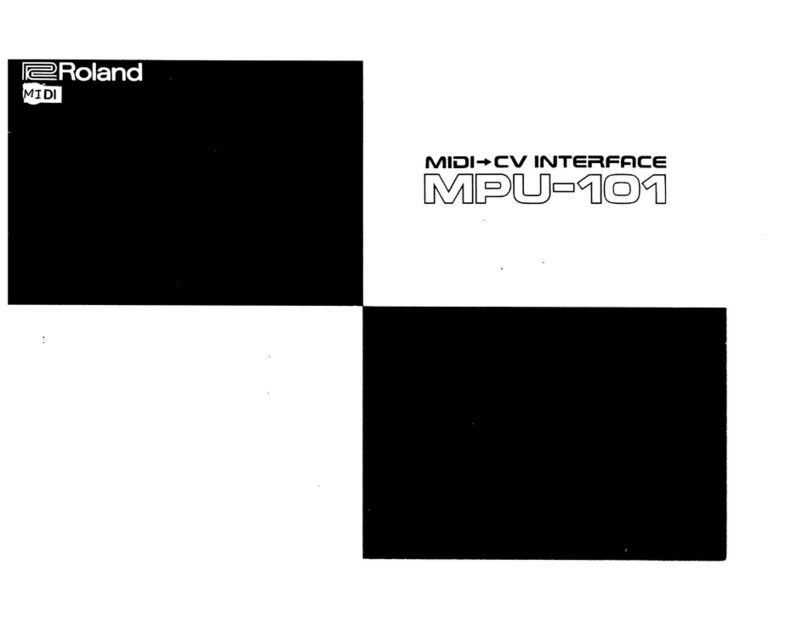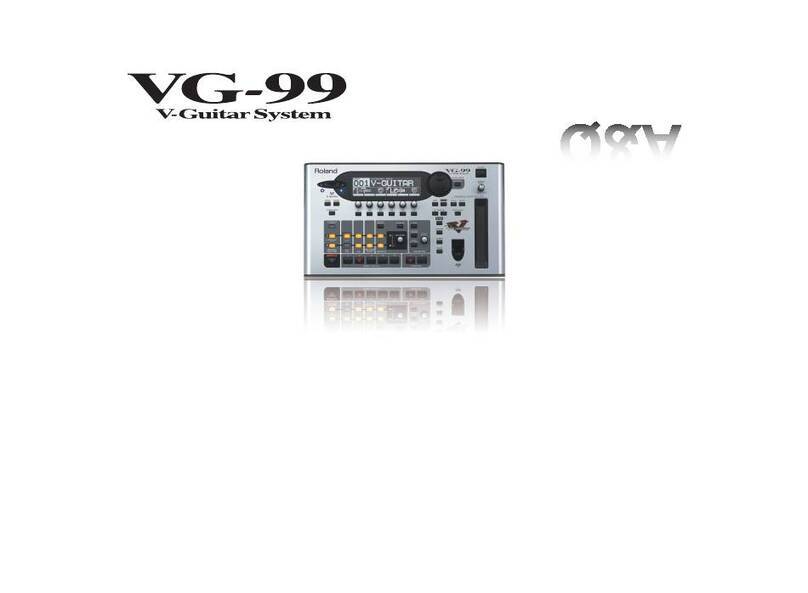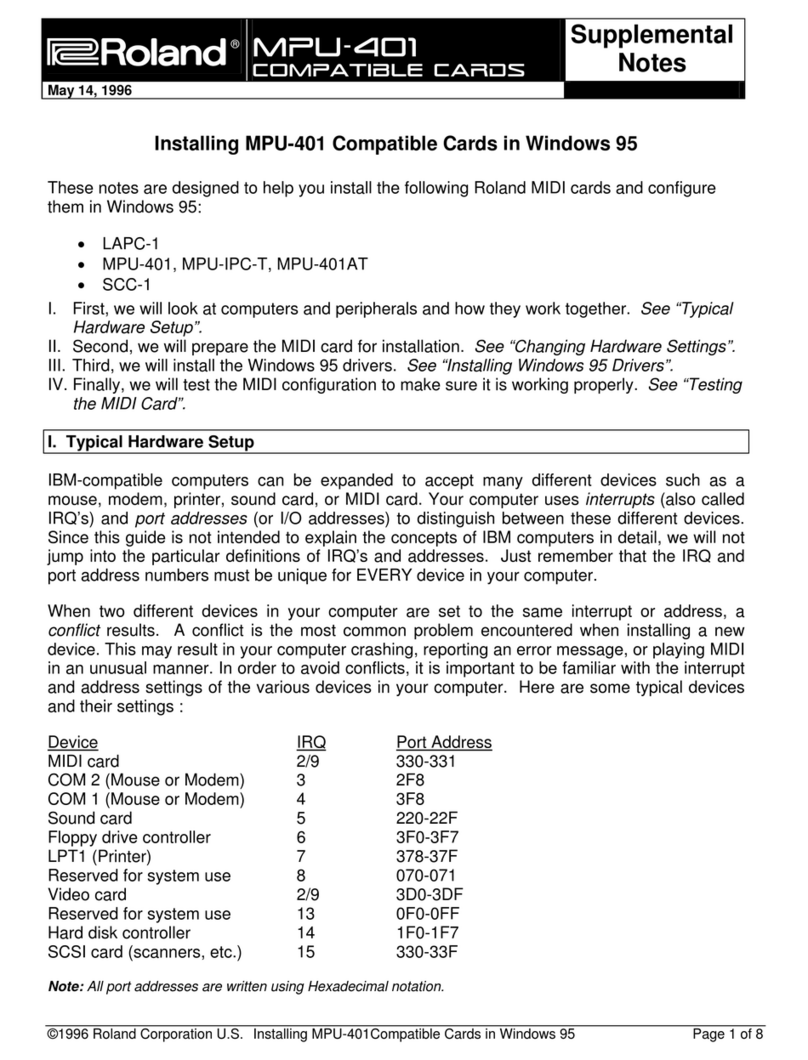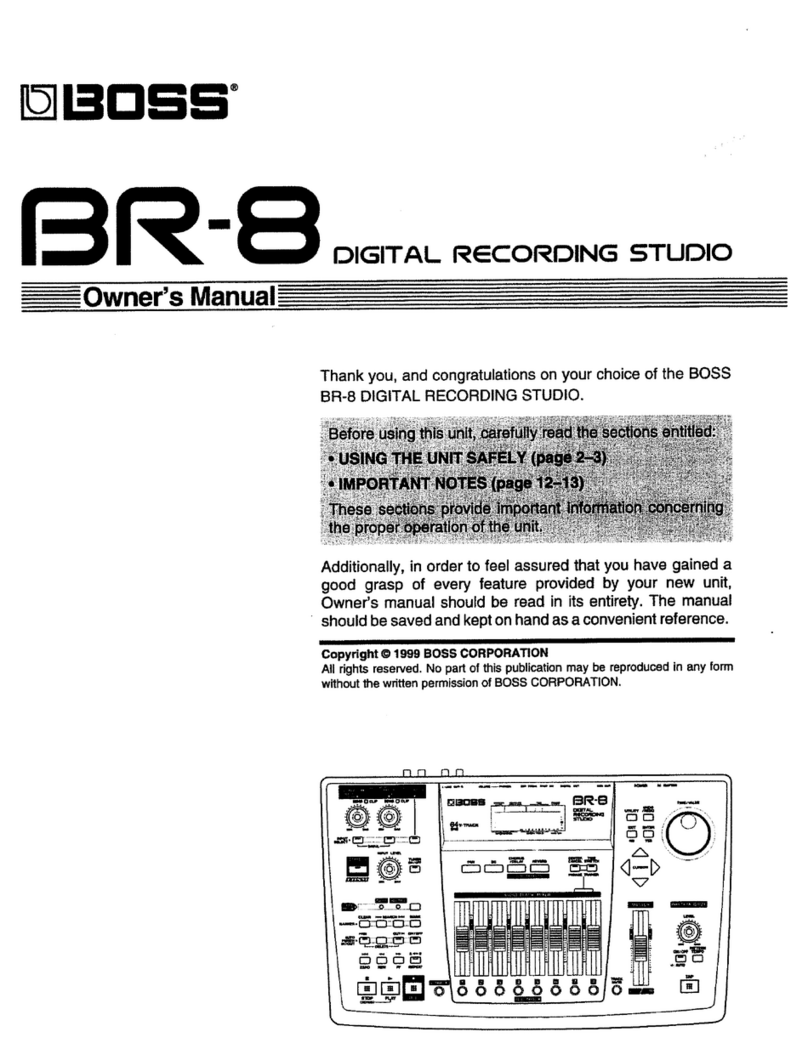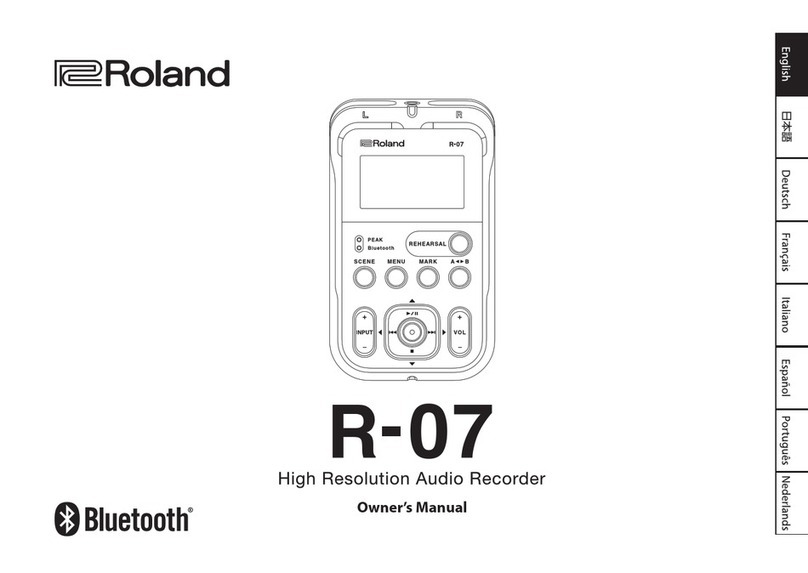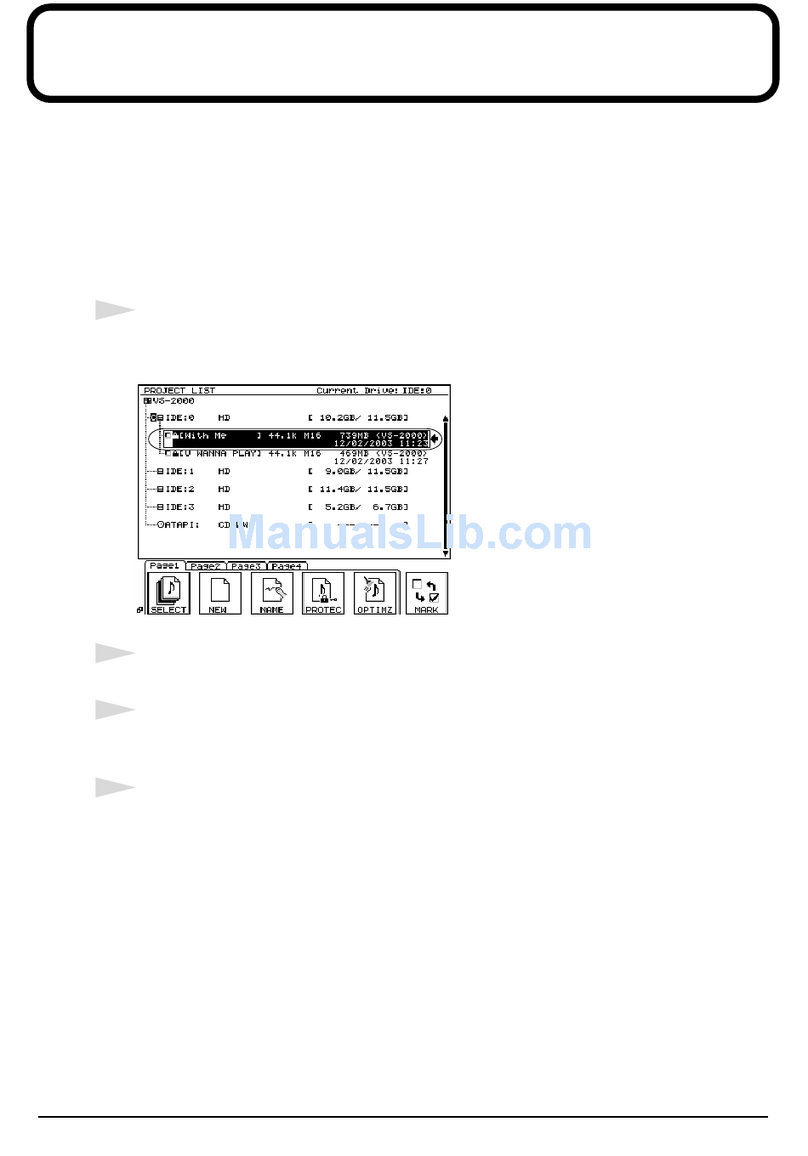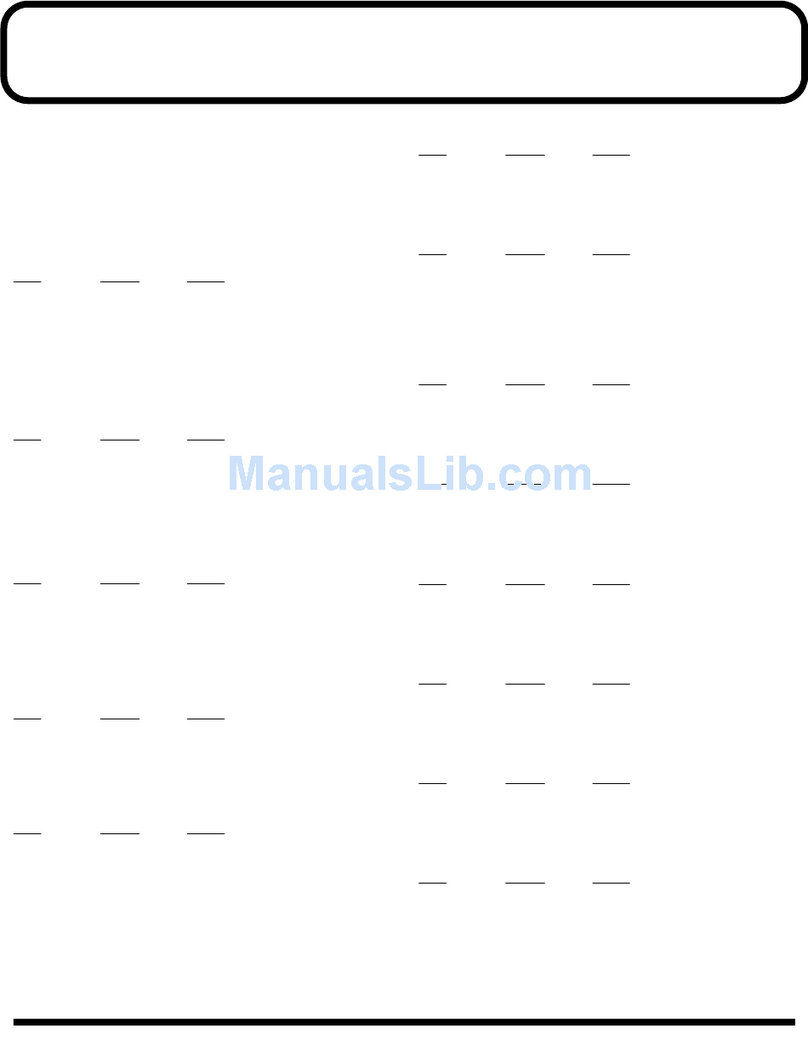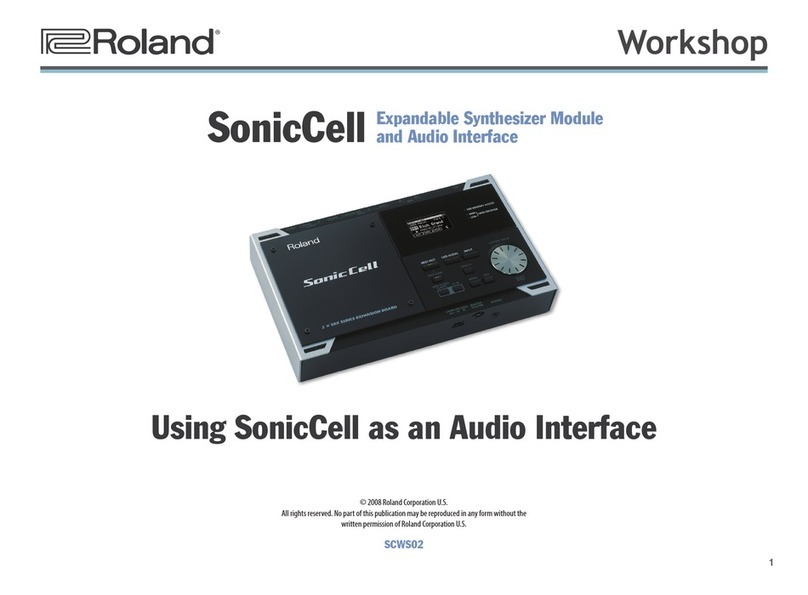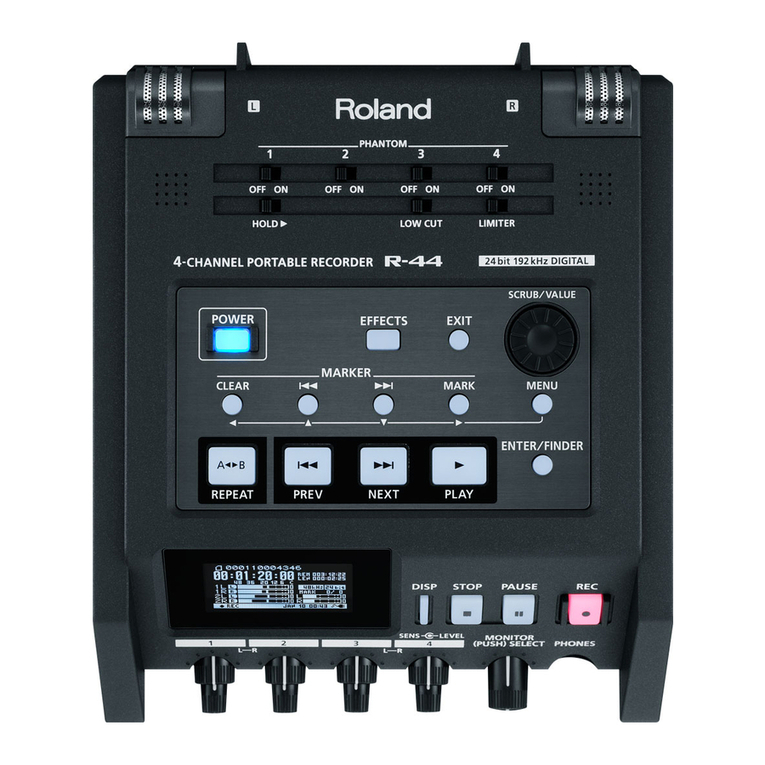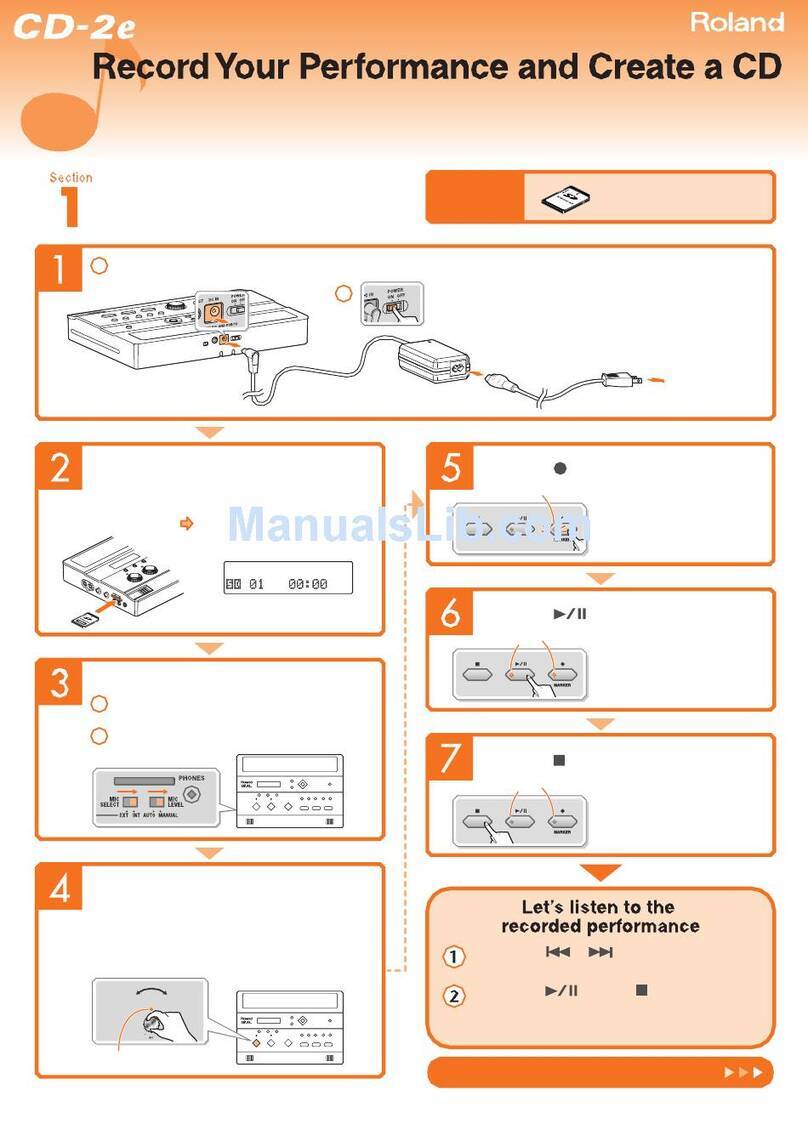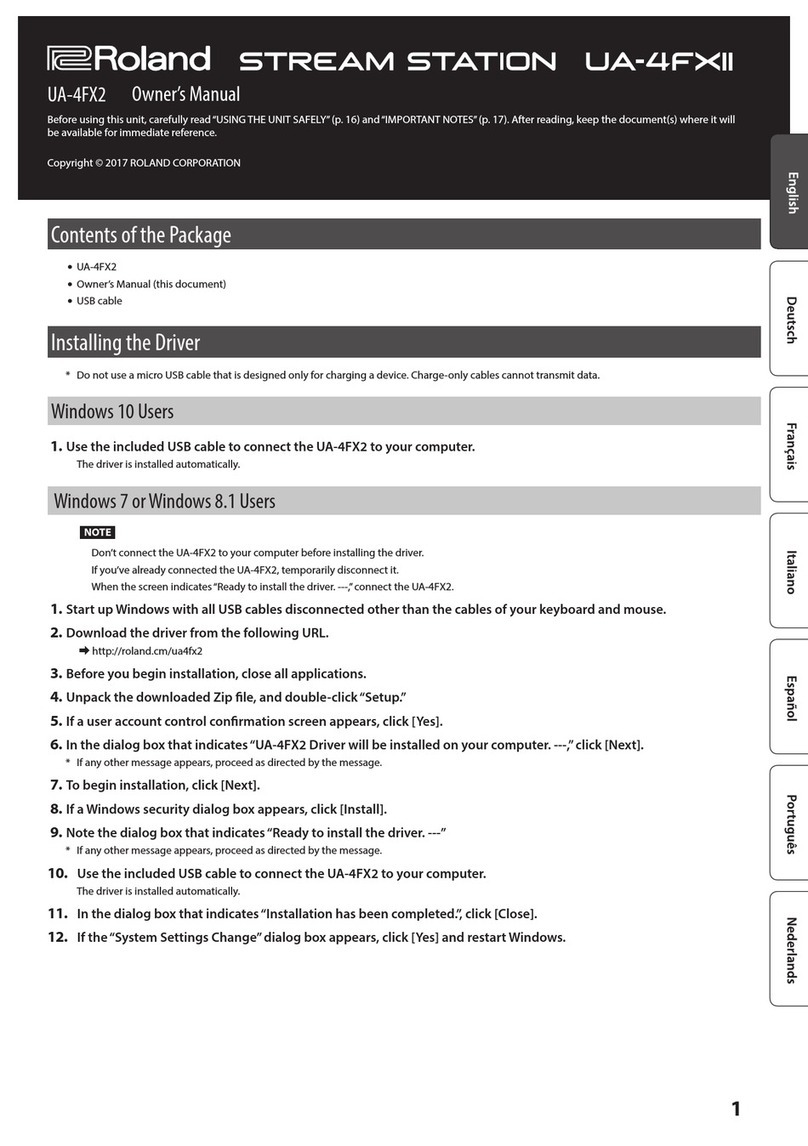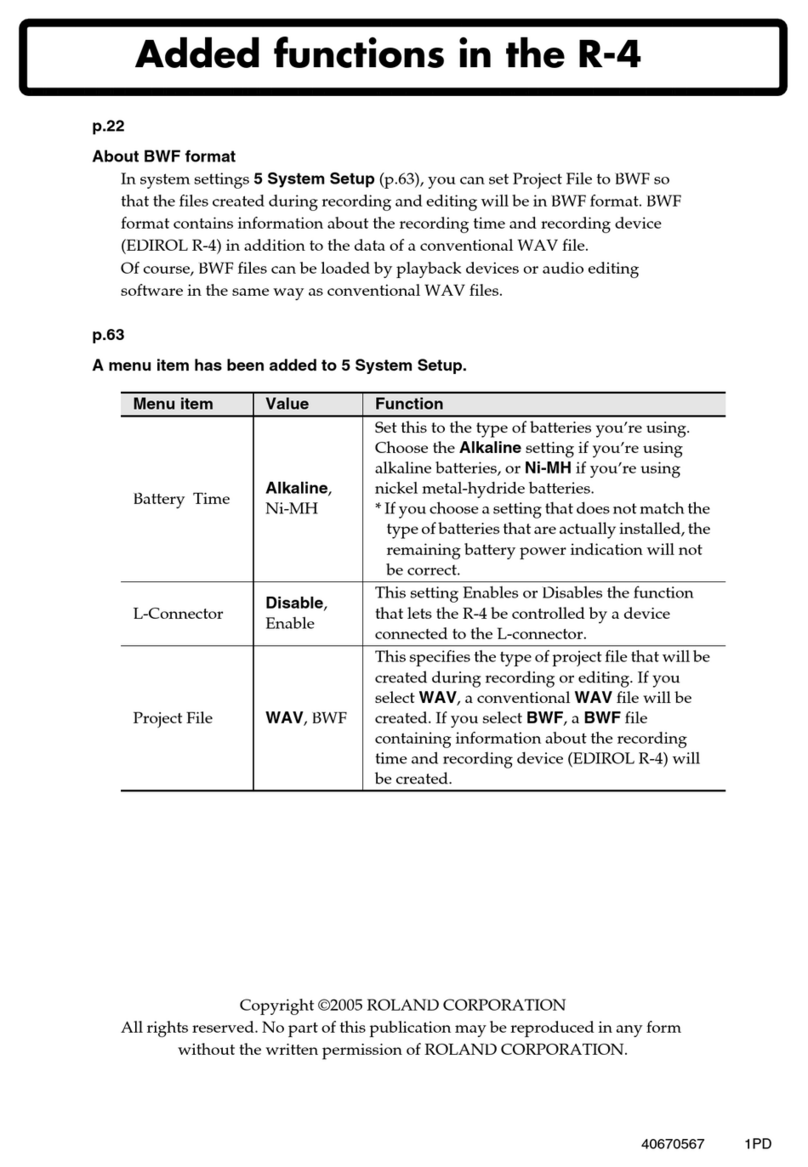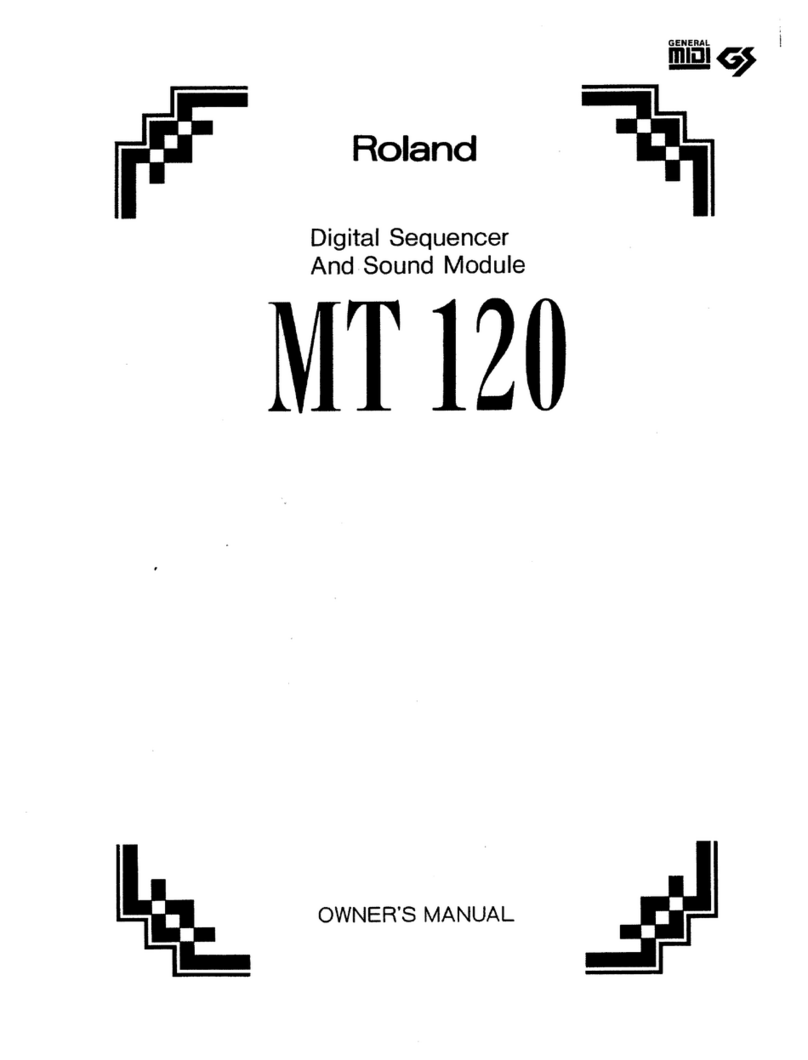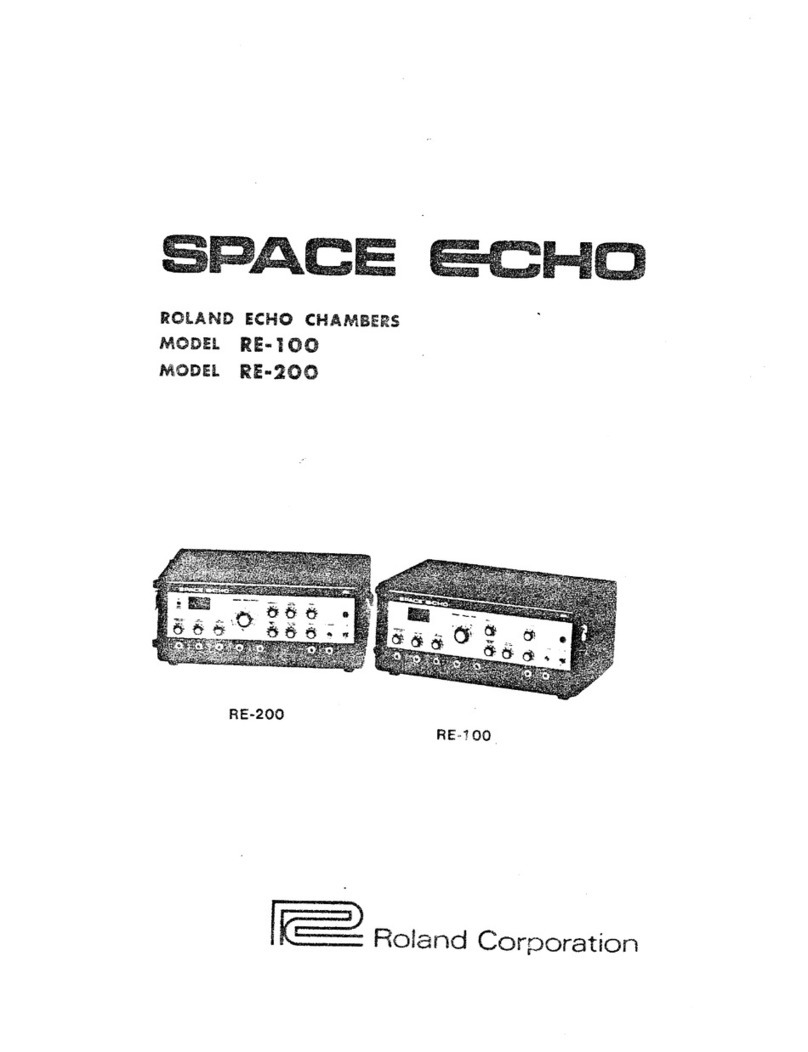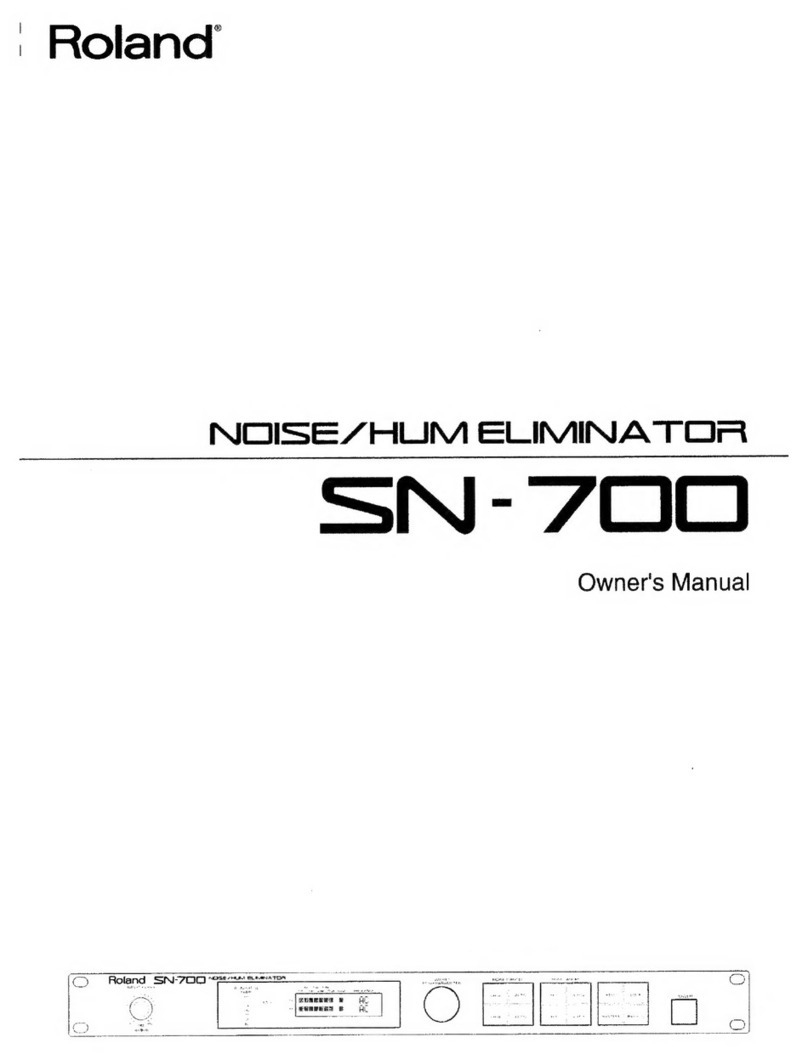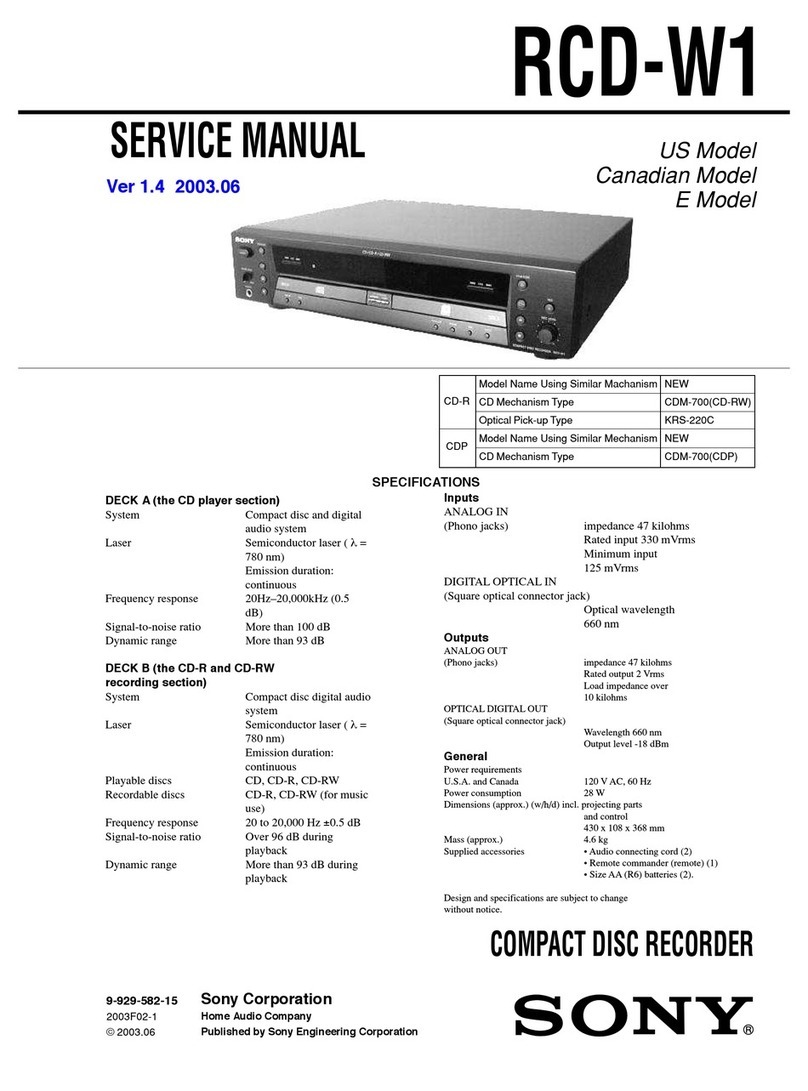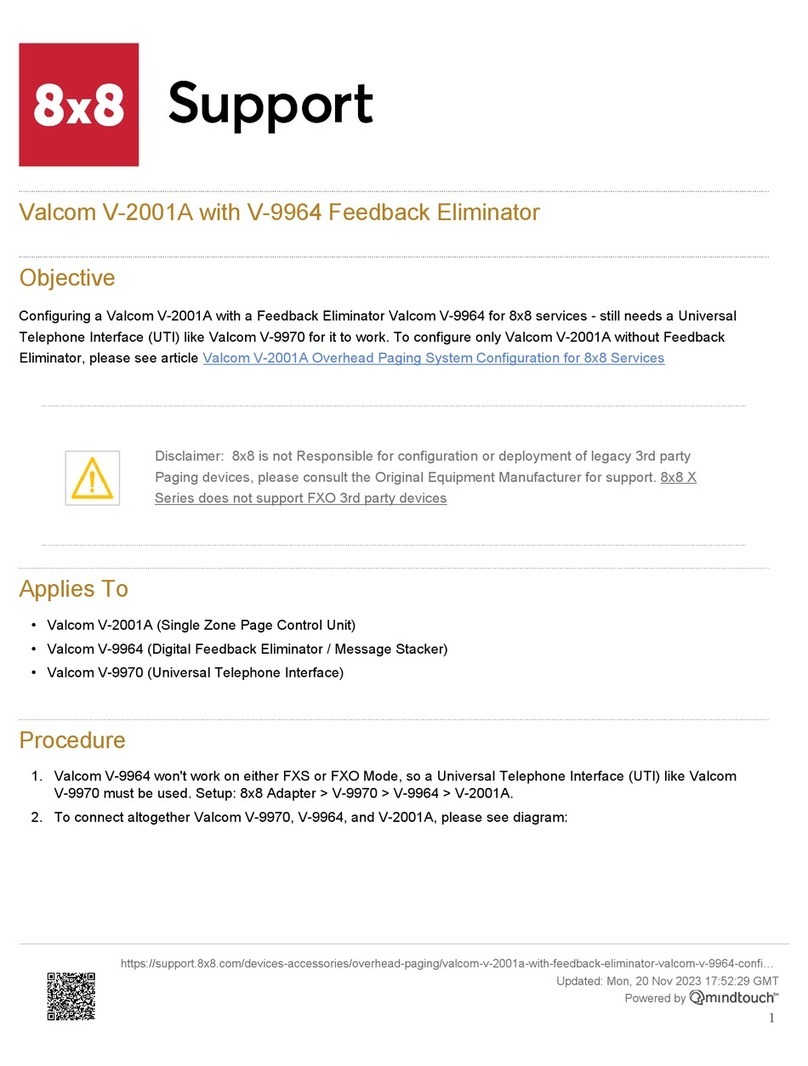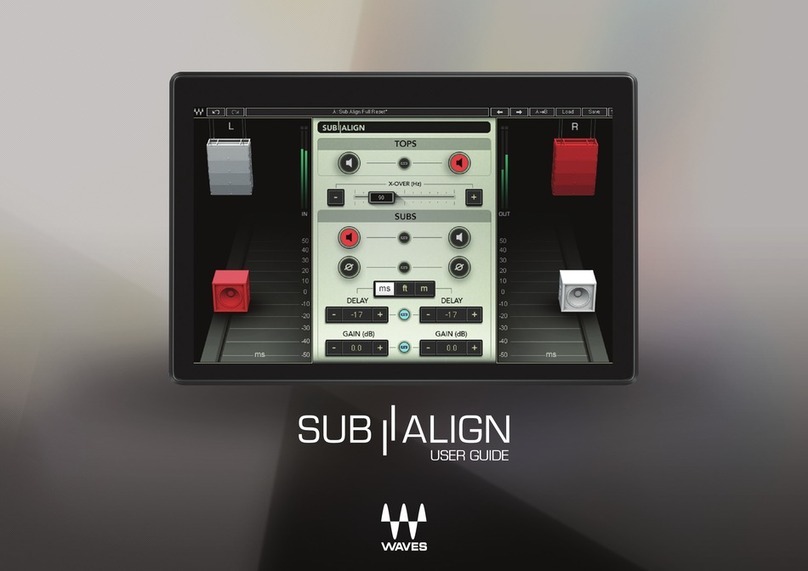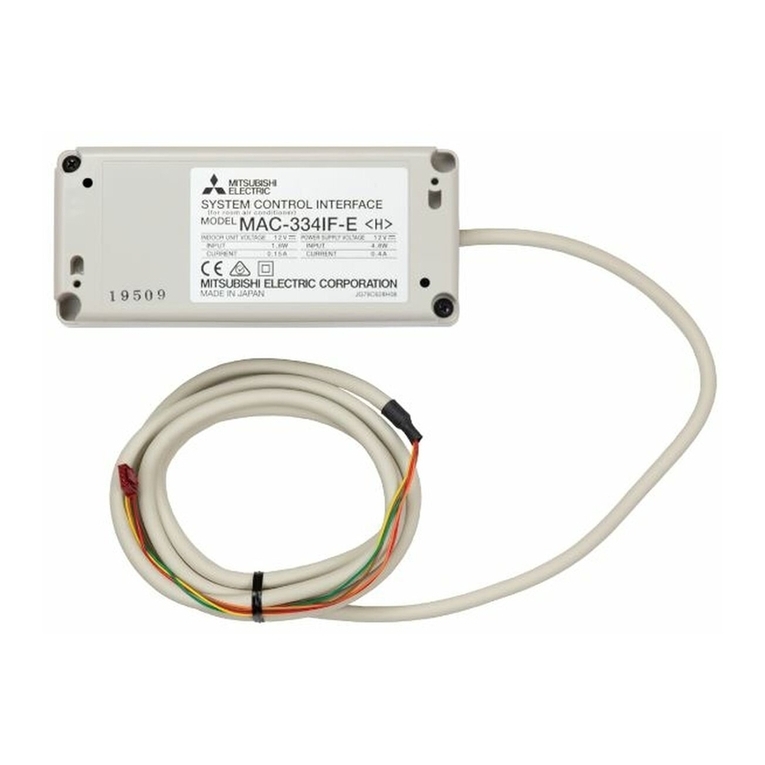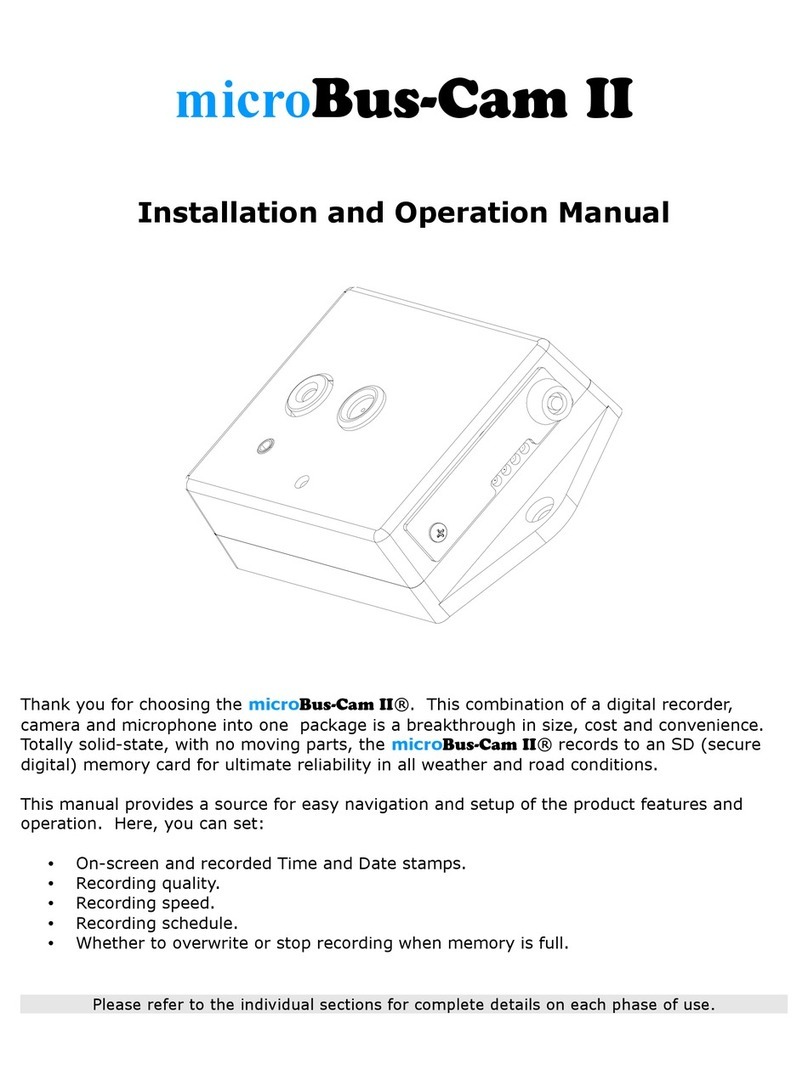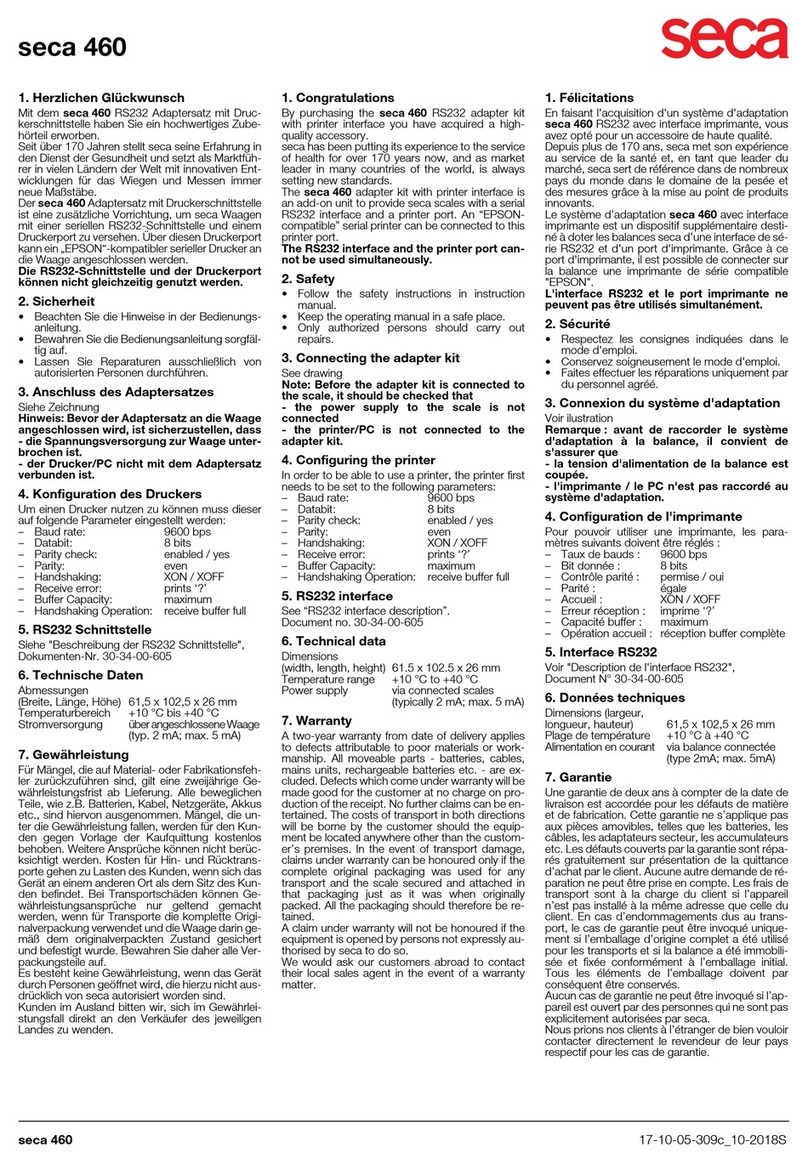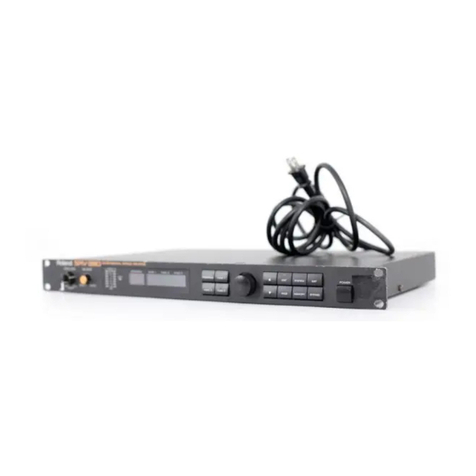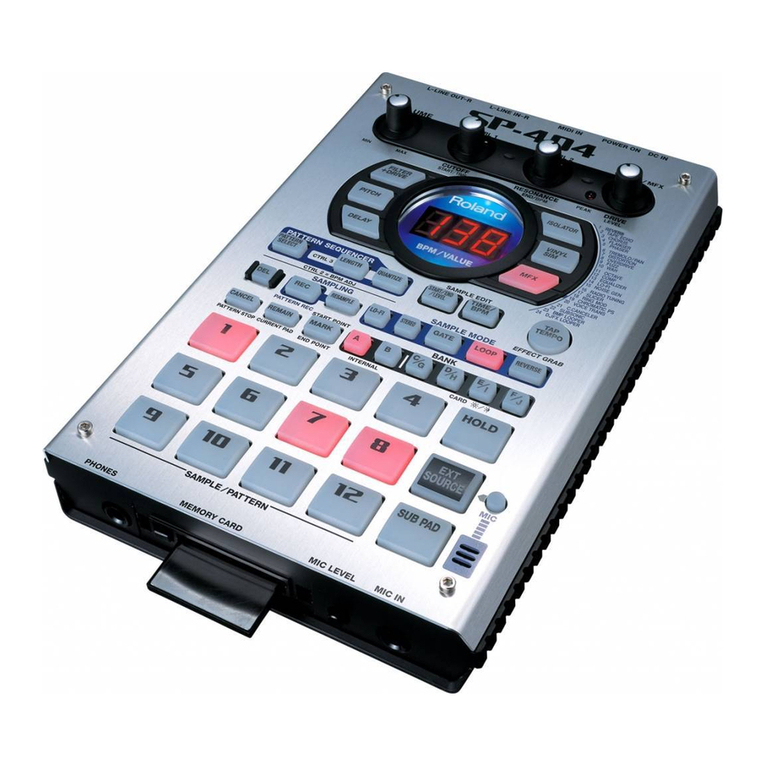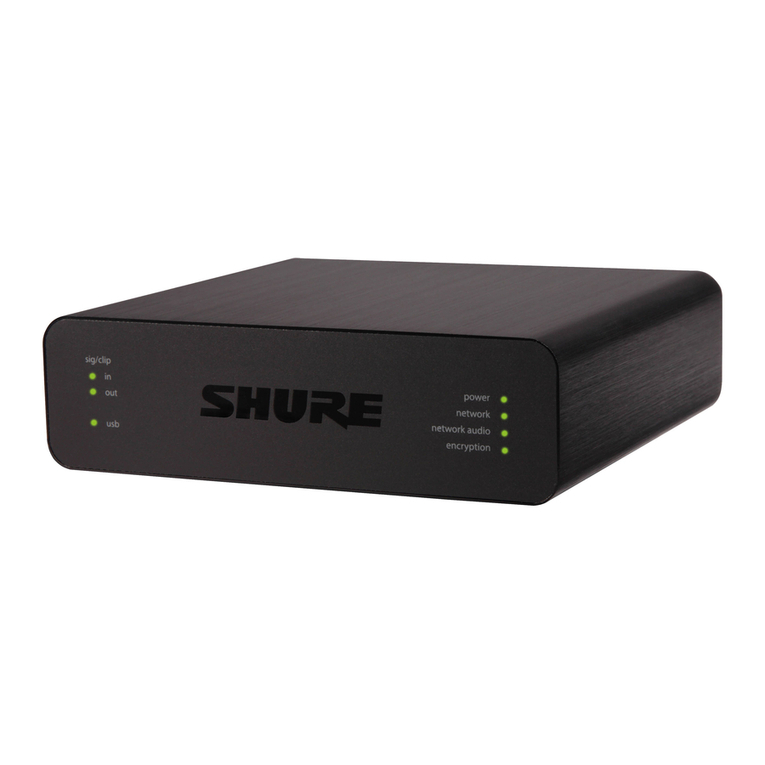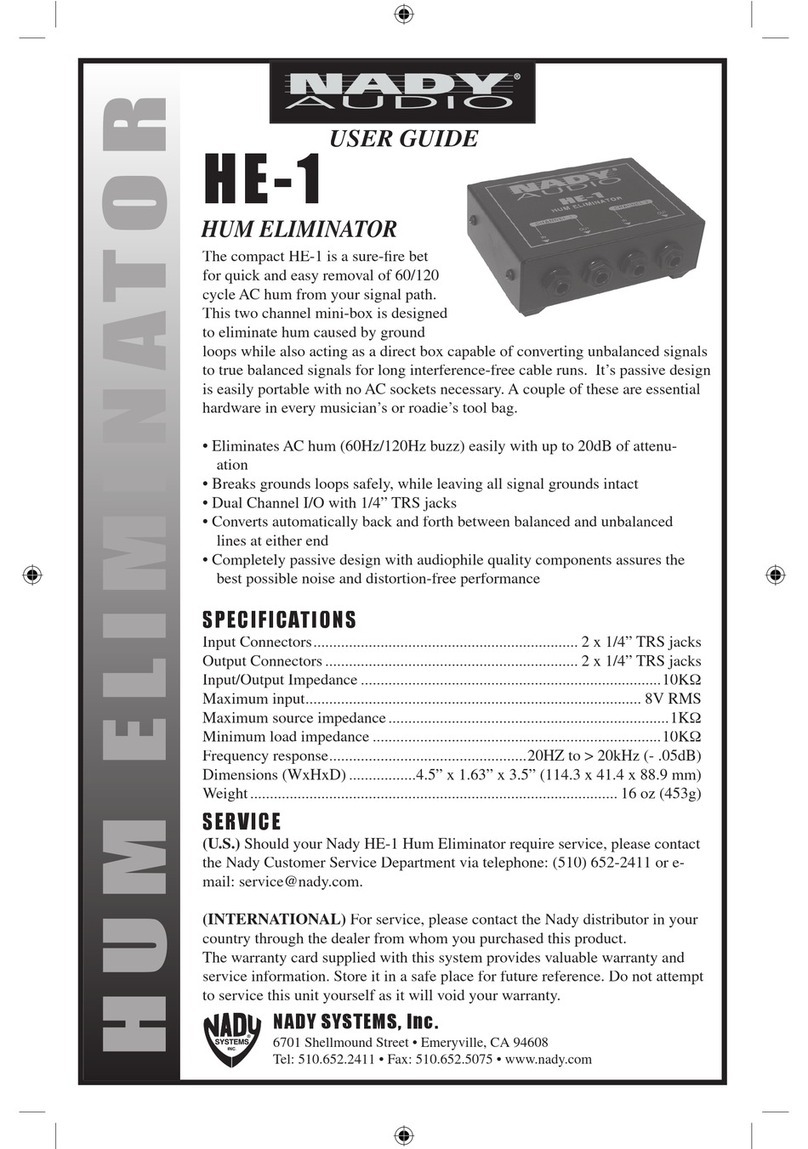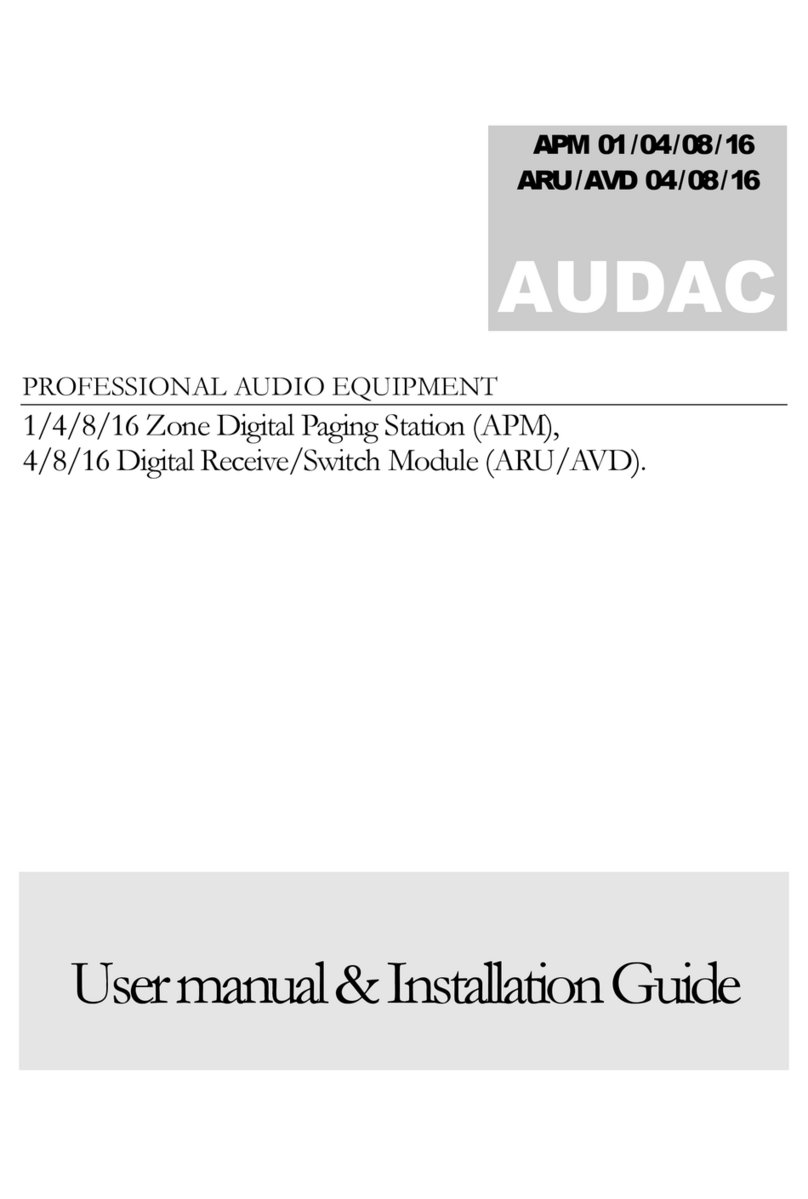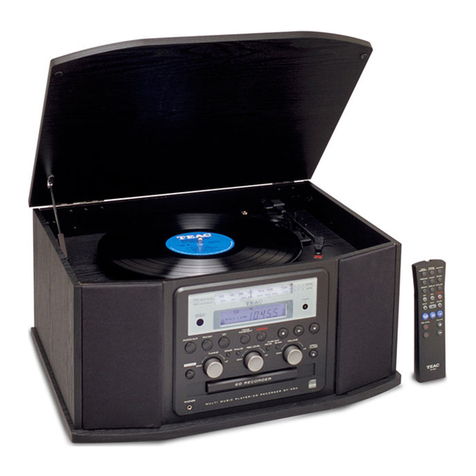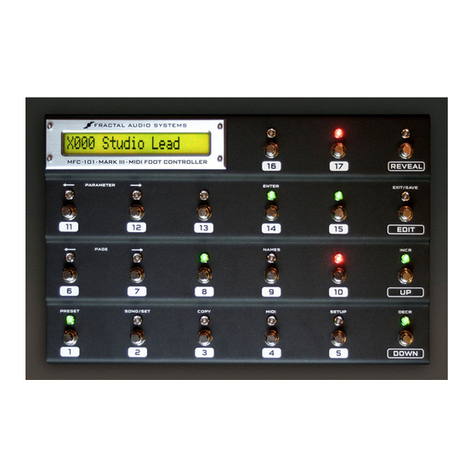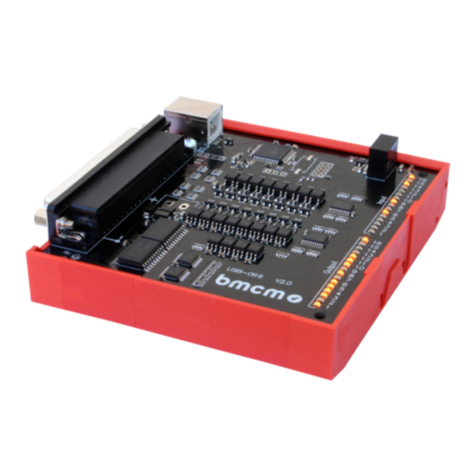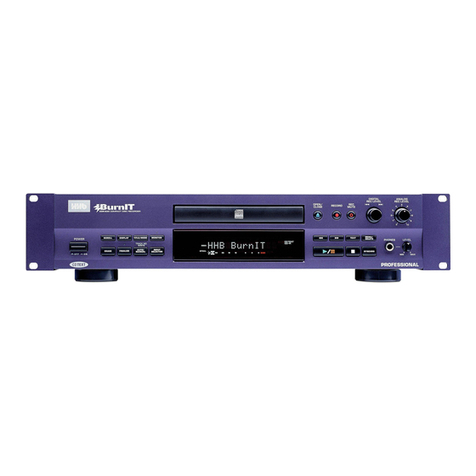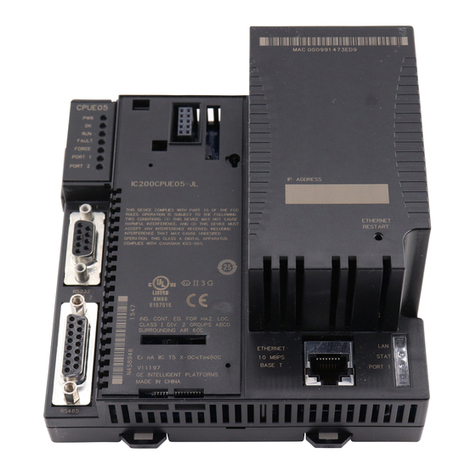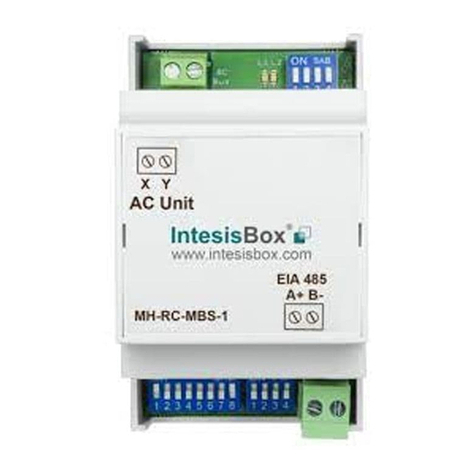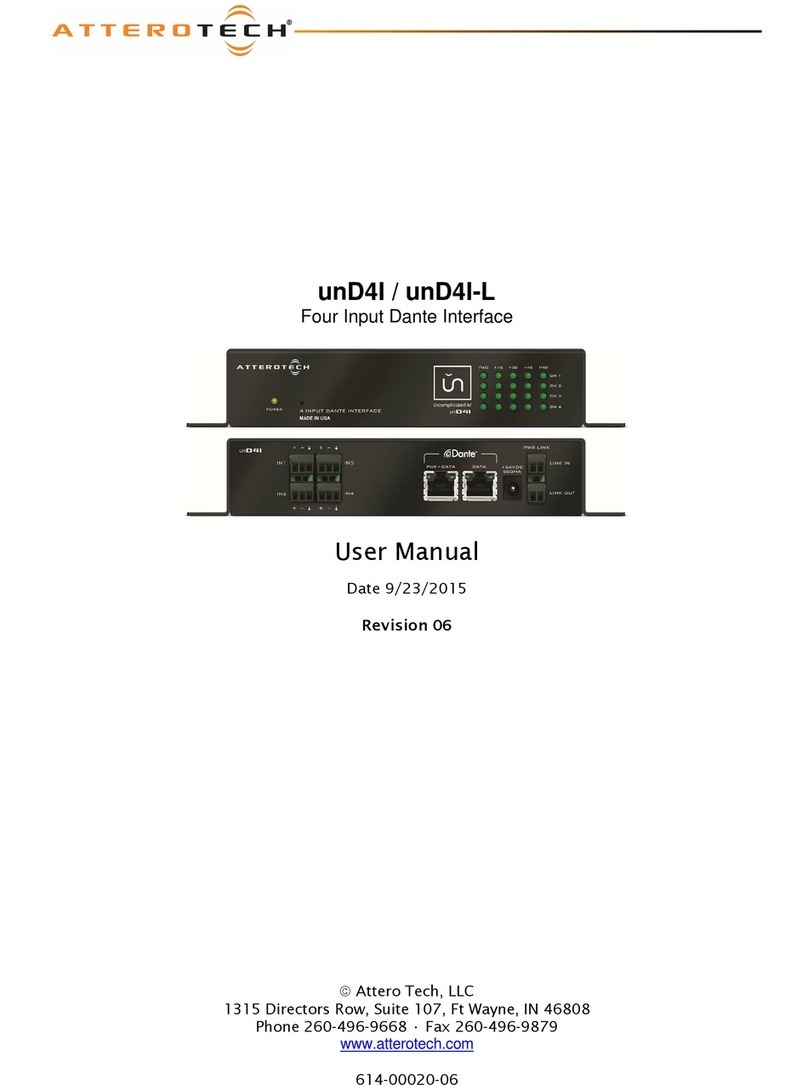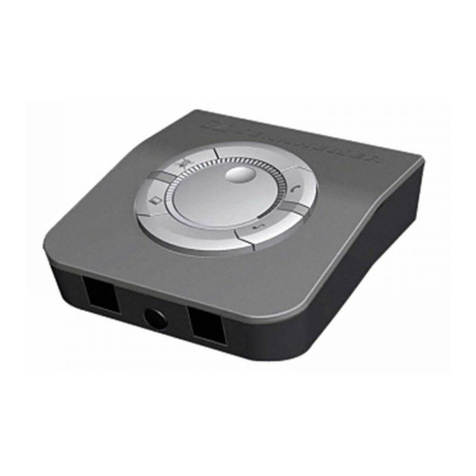
English
Owner’s ManualSOUND MODULE
JU-06
Settings
Numeric buttons [1]–[16]
In Settings mode, the 16 numeric buttons shown in the
illustration are called the [1]–[16] buttons.
SOLO/UNISON/POLY/Octave Shift/Portamento
1. While holding down the [CHORUS 2] button, specify the value by using the numeric buttons shown in
the following table or the C1/C2 ribbon controller.
Parameter Value setting Explanation
SOLO/
UNISON/
POLY mode
[14] Plays monophonically (SOLO).
[15] Plays all sounds in unison (UNISON).
[16] Plays polyphonically (POLY).
Octave Shift
*1
[4]–[13]
(-4–+5)
Shifts the keyboard range in steps of one octave.
For the ±0 (default) setting, [8] is lit.
Portamento
Switch
C1
(OFF/ON) Creates a smooth change in pitch between one key and the next key played.
Portamento
Time
C2
(0–100) Adjusts the time required for the pitch change.
System Settings
1. While holding down the [MANUAL] button, press one of the numeric buttons shown in the following
table to select the parameter.
* Keep holding down the [MANUAL] button.
2. Press a numeric button to select the value, and release the [MANUAL] button to conrm the value.
Parameter Select Value
setting Explanation
Master Tune [MANUAL]
+ [1]
[1]–[16]
(433–448 Hz)
Species the master tuning.
For the 440 Hz (default) setting, [8] is lit.
MIDI
Channel
[MANUAL]
+ [2] [1]–[16] Species the MIDI transmit/receive channel (1–16).
MIDI Clock
Source
[MANUAL]
+ [3]
[1] (AUTO)
If MIDI clock is being input to the MIDI IN connector or the USB
port, the JU-06’s tempo will automatically synchronize to MIDI clock
(default).
[2]
(INTERNAL)
The JU-06 operates at the tempo specied on the unit itself. Choose
the “INTERNAL”setting if you don’t want to synchronize to an external
device.
Transpose
*1
[MANUAL]
+ [4]
[2]–[13]
(-6–+5)
Transposes the keyboard range in semitones.
For the ±0 (default) setting, [8] is lit.
Key Velocity
*1
[MANUAL]
+ [5]
Adjusts the velocity value that will be transmitted when you play the keyboard.
[1] (TOUCH) Actual keyboard velocity will be transmitted.
[2] (64) A xed velocity value (64 or 127) will be transmitted regardless of how
you play.
[3] (127)
Velocity
Curve
*1
[MANUAL]
+ [6]
Sets the keyboard’s touch.
[1] (LIGHT) Sets the keyboard to a light touch.
[2] (MEDIUM) Sets the keyboard to the standard touch.
[3] (HEAVY) Sets the keyboard to a heavy touch.
Auto O [MANUAL]
+ [7]
[1] (OFF) The power does not turn o automatically.
[2] (30 min) The power turns o automatically after 30 minutes.
* Auto O does not occur while USB-connected.
LED Demo [MANUAL]
+ [8]
[1] (OFF)
Species the time until the LED DEMO is shown.
[2] (1 min)
[3] (3 min)
[4] (10 min)
Chain Mode [MANUAL]
+ [9]
Although the JU-06 is four-note polyphonic, you can
increase the polyphony by using a MIDI cable to
connect two or more JU-06 units and turning Chain
mode on.
* If you’re using two JU-06 units, it is a good idea to match their patch settings by
using the “Data Backup/Restore” procedure.
[1] (OFF) If Chain mode is on, the fth voice and subsequent notes are passed
“thru”via MIDI OUT.
[2] (ON)
Ribbon
Controller
Note Scale
[MANUAL]
+ [10] [1]–[16]
Sets the note scale type of the ribbon controller (default: [1]).
For details, refer to“JU-06 Sound List” (PDF).
& http://www.roland.com/manuals/
Patch settings
Bend Range [MANUAL]
+ [13]
[1]–[12],
[13] (2 oct),
[16] (OFF)
Species the Pitch Bend Range in semitones.
(default: [2])
Delay Level [MANUAL]
+ [14]
[1]–[16]
Adjusts the volume of delay sound. (OFF=[1])
Delay Time [MANUAL]
+ [15] Adjusts the delay time (the time by which the sound is delayed).
Delay
Feedback
[MANUAL]
+ [16] Adjusts the delay feedback. (OFF=[1])
*1 Only when using the K-25m keyboard unit (sold separately)
1 2 3 4 5 6 7 8 9 10 11 12 13 14 15 16
MIDI INMIDI OUT
Introduction
The JU-06 is a sound module that can be used in conjunction with the K-25m keyboard unit (sold separately).
The sound can be heard through the built-in speakers.
* The JU-06 can operate on batteries or on USB bus power. If you are using batteries, insert four AA batteries,
making sure that the batteries are oriented correctly.
* When turning the unit over, be careful so as to protect the buttons and knobs from damage. Also, handle
the unit carefully; do not drop it.
* When the batteries run low, the LED above the Ribbon Controller C1 ( 2) blinks. Install new batteries.
Using the JU-06 in conjunction with the K-25m keyboard unit (sold
separately)
& For installation, refer to the K-25m’s Owner’s Manual.
Playing the JU-06 via MIDI or USB
You can also play the JU-06 via MIDI or USB. For details, refer to“Connecting Your Equipment.”
Connecting Your Equipment
* To prevent malfunction and equipment failure, always turn down the volume, and turn o all the units
before making any connections.
G
A B C D E F
AMicro USB (O) port
Use a commercially available USB 2.0 cable (A-microB) to connect this port to your computer. It can be used
to transfer USB MIDI and USB audio data. You must install the USB driver when connecting the JU-06 to
your computer. Download the USB driver from the Roland website. For details, refer to Readme.htm which is
included in the download.
& http://www.roland.com/support/
B[VOLUME] knob
Adjusts the volume.
CPHONES jack
Connect headphones (sold separately) here.
DOUTPUT jack
Connect this jack to your amp or monitor speakers.
EINPUT jack
This is the audio input jack. Sound from the connected device is output
from the OUTPUT jack and PHONES jack.
FMIDI connectors
You can play the JU-06 by connecting a MIDI device via a commercially
available MIDI cable.
Turning the Power On
G[POWER] switch
This turns the power on/o.
* After you’ve made connections correctly, be sure to turn on the power in the order of the JU-06 rst, and
then the connected system. Powering-on in the incorrect order may cause malfunctions or damage. When
turning the power o, power-o the connected system rst, and then the JU-06.
* This unit is equipped with a protection circuit. A brief interval (a few seconds) after turning the unit on is
required before it will operate normally.
* Before turning the unit on/o, always be sure to turn the volume down. Even with the volume turned down,
you might hear some sound when switching the unit on/o. However, this is normal and does not indicate
a malfunction.
Restoring the Factory Settings (Factory Reset)
Here’s how to return the JU-06 to its factory-set state.
1. While holding down the BANK [1] button, turn on the power.
The [MANUAL] button blinks.
If you decide to cancel the factory reset, turn o the power.
2. Press the [MANUAL] button to execute the factory reset.
3. When all buttons blink, turn the JU-06’s power o, then on again.
Data Backup/Restore
Backup
1. While holding down the BANK [2] button, turn on the power.
2. Connect your computer to the JU-06’s USB port via USB cable.
3. Open the “JU-06” drive on your computer.
The backup les are located in the“BACKUP” folder of the“JU-06” drive.
4. Copy the backup les into your computer.
5. After copying is completed, eject the USB drive and then disconnect the USB cable.
Windows 8/7
Right-click on the “JU-06”icon in “My Computer”and execute “Eject.”
Mac OS
Drag the “JU-06” icon to the Trash icon in the Dock.
6. Turn the JU-06 power o.
Restore
1. As described in the procedure for “Backup”Step 1–3, open the “JU-06” drive on your computer.
2. Copy the JU-06 backup les into the“RESTORE”folder of the “JU-06” drive.
3. After copying is completed, eject the USB drive and then press the [MANUAL] button.
4. After the LEDs have completely stopped blinking, turn o the power.
JU-06MIDI keyboard
MIDI INMIDI OUT
Panel Descriptions
Main Specications Roland JU-06::SOUND MODULE
Maximum Polyphony 4 voices
Power Supply Rechargeable Ni-MH battery (AA, HR6) x 4, Alkaline battery (AA, LR6) x 4,
USB bus power
Current Draw 500 mA (USB bus power)
Dimensions 300 (W) x 128 (D) x 45 (H) mm 11-13/16 (W) x 5-1/16 (D) x 1-3/4 (H) inches
Weight
(including batteries) 940 g 2 lbs 2 oz
Accessories Owner’s Manual, Leaet“USING THE UNIT SAFELY,” Alkaline battery (AA, LR6) x 4
Options
(sold separately) Keyboard unit: K-25m
* In the interest of product improvement, the specications and/or appearance of this unit are subject to
change without prior notice.
In order to use this device correctly, please carefully read “USING THE UNIT SAFELY” and“IMPORTANT NOTES”(the “USING THE UNIT SAFELY” leaet) before use.
After reading, keep these instructions at hand for immediate reference.
7VCA
Here you can adjust the amount of time-varying change (envelope) for the volume.
Controller Explanation
[ ] switch Selects whether the volume is controlled by 8ENV (envelope) ( ) or by the gate
signal ( ).
[LEVEL] slider Adjusts the volume of the patch.
8ENV
Here you can create time-varying change (envelope).
Controller Explanation
[A] slider Attack time
[D] slider Decay time
[S] slider Sustain level
[R] slider Release time
1
2 3 4 5 6 7 8
1Common section
Here you can switch the sound (patch/bank).
Controller Explanation
BANK [1]–[8] buttons
PATCH NUMBER [1]–[8]
buttons
What is “Patch/Bank”?
You can store/recall up to 64 sets (8 patches x 8 banks) of sound settings.
To switch the bank/patch
1. Press the BANK [1]–[8] buttons to switch the bank.
2. Press the PATCH NUMBER [1]–[8] buttons to switch the patch.
* For each sound, refer to“JU-06 Sound List” (PDF).
&http://www.roland.com/manuals/
To store the patch
* When you edit a patch, a dot appears in the display.
1. Press the save-destination BANK [1]–[8] button.
2. Long-press the save-destination PATCH NUMBER [1]–[8] button.
[CHORUS 1] button
[CHORUS 2] button Turns the chorus eect-1/2 On/O.
[MANUAL] button Causes sound to be produced according to the current settings of the sliders.
2Ribbon controller (C1/C2)
These are touch-type ribbon controllers. C1 (left) is pitch bend, and C2 (right) is modulation.
* If a K-25m keyboard unit, USB, or MIDI are not connected, touching the C1 controller plays a preview sound.
3LFO
Here you can create cyclic change (modulation) in the sound.
Controller Explanation
[RATE] slider Determines the speed of the LFO.
[DELAY TIME] slider Species the time from when the tone sounds until the LFO reaches its maximum
amplitude.
4DCO
Here you can select the waveform that determines the character of the sound, and specify its pitch.
Controller Explanation
RANGE [16] [8] [4]
buttons Species the octave of the oscillator.
[LFO] slider Allows the LFO to modulate the pitch, producing a vibrato eect.
[PWM] slider
When the [LFO/MAN] switch is“MAN” (MANUAL):
Adjusts the value of the pulse width.
When the [LFO/MAN] switch is“LFO”:
Adjusts the modulation depth.
What is “Pulse Width”?
Pulse width is the amount of the upper portion of the pulse wave, expressed as a
percentage of the overall wavelength. If the upper and lower widths are not the same,
the waveform is called an asymmetric pulse wave.
[LFO/MAN] switch Selects whether the pulse width value is a xed value specied manually by the [PWM]
slider (MAN) or is varied by the 3LFO (LFO).
[ ] button Selects the waveform that is the basis of the sound.
(Square wave/Asymmetrical pulse wave), (Sawtooth wave)
[ ] button
[SUB] slider Adjusts the volume of the sub oscillator.
[NOISE] slider Adjusts the volume of the noise.
5HPF
This is a high-pass lter that passes the high frequencies and cuts the low frequencies.
Controller Explanation
[FREQ] slider Species the cuto frequency of the high-pass lter. Frequency components below
the cuto frequency are cut.
6VCF
This is a low-pass lter that passes the low frequencies and cuts the high frequencies.
Controller Explanation
[FREQ] slider Species the cuto frequency of the low-pass lter. Frequency components above
the cuto frequency are cut, making the sound mellower.
[RES] slider
Resonance boosts the sound in the region of the lter’s cuto frequency.
Higher settings produce stronger emphasis, creating a distinctively“synthesizer-like”
sound.
[ ] switch Selects the polarity (direction) of the envelope.
[ENV] slider Adjusts the depth by which the 8ENV (envelope) controls the cuto frequency.
[LFO] slider Uses the 3LFO to vary the cuto frequency.
[KYBD] slider
Adjusts the way in which the pitch of the note aects the cuto frequency (key
follow) when using the keyboard to control cuto frequency. Moving the slider
downward causes the cuto frequency to fall as you play higher on the keyboard.
Step Sequencer
The step sequencer lets you input a note at each of up to 16 steps, and play back the notes as a loop.
You can change the number of steps between 1 and 16. Up to 16 patterns can be stored.
1. Press the [CHORUS 2] and [MANUAL] buttons (SEQ) simultaneously to enter the Step Sequencer mode.
The [s] button blinks.
* To exit the Step Sequencer mode, press again [CHORUS 2] and [MANUAL] buttons simultaneously.
Step buttons [1]–[16]
In Step Sequencer mode, the 16 numeric buttons shown in
the illustration are called [1]–[16] (Step buttons).
Function Controller
Play start/stop [MANUAL] (s)
Tempo [CHORUS 2] + C1
On/o status of each step [1]–[16]
Enter a note [1]–[16] + C1 (or keyboard)
Enter a tie Step button + Next step button (e.g.: [1] + [2])
Enter a gate time [1]–[16] + C2
Set the gate time of all steps [CHORUS 2] + C2
Select a pattern (1–16) [CHORUS 2] + [1]–[16]
Write the pattern (1–16) [CHORUS 2] + [1]–[16] (long-press)
Pattern settings
Number of steps (1–16) [MANUAL] + [1] &[1]–[16]
Shue [MANUAL] + [2] &[4]–[12] (default: [8])
Scale [MANUAL] + [3] &
1
[1]
[2]
[3]
[4]
2 3 4 5 6 7 8 9 10 11 12 13 14 15 16
(default: [2])
Sequencer settings *1
Step order type [MANUAL] + [15] &
[1] Normal (default), [2] Even/Odd reverse, [3] Odd only,
[4] Even only, [5] Odd only 0Even only,
[6] Even only 0Odd only, [7] Random
O step mode [MANUAL] + [16] &[1] Rest (default), [2] Skip
*1 Sequencer settings return to the default setting when the power is turned o.
Inputting steps
1. Hold down the step button ([1]–[16] buttons) at which you want to enter a note.
2. While holding down the step button, play the keyboard. Alternatively, use the C1 ribbon controller to
specify the note.
3. Release the step button.
4. Press the [s] button to play back.
* To delete the note at a step, turn o a step button ([1]–[16]) that contains a note (making the button go dark).
1 2 3 4 5 6 7 8 9 10 11 12 13 14 15 16



